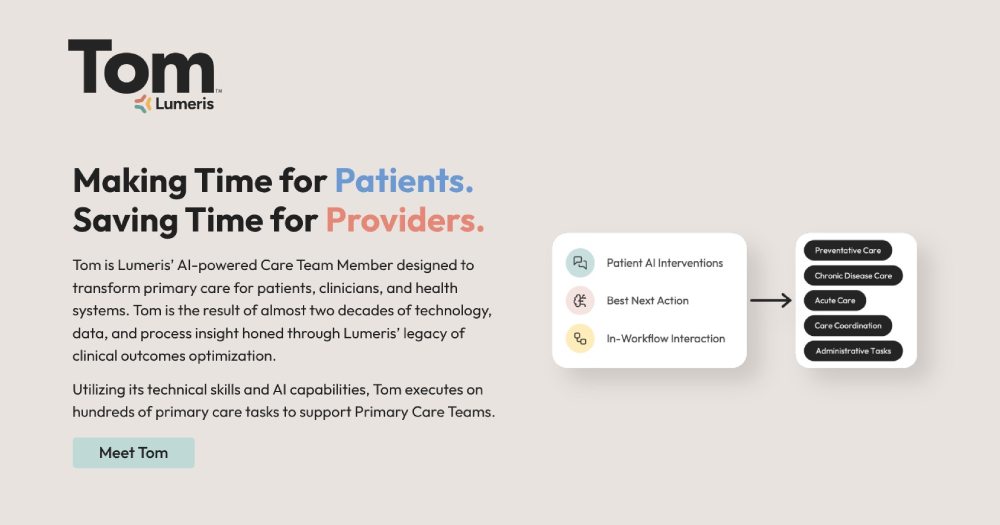Meet Tom, an AI-powered care team member that aims to transform primary care

Primary care in the U.S. (and elsewhere) is in crisis. Millions of Americans lack access to a primary care provider, and the system is buckling under the strain. The numbers are staggering: a 2-billion-hour care gap that can't be filled with human resources alone.
And so Maryland Heights, Missouri-based Lumeris developed Tom, an AI-powered assistant designed to close the gap, ease the burden on physicians, and make healthcare more accessible. Unveiled at ViVE 2025 in Nashville, Tom could be a real game-changer in primary care.
How does it work?
Tom isn't just a passive system that spits out data — it acts. It integrates directly into clinical workflows, working 24/7 to execute critical tasks that would otherwise bog down primary care teams. Think about scheduling screenings, checking in on medication adherence, coordinating post-discharge care, and personalizing patient education.
Tom is built on two decades of physician-centered research and five years of AI innovation, using large language models and curated data to optimize care decisions.
And it's not just about efficiency. "We can extend primary care to 100 million Americans who don't have access," says John Doerr, chairman of Kleiner Perkins. "We can upgrade the quality of care for all patients and lower costs by 50% or more."
Why does it matter?
The stakes couldn't be higher. Primary care is the frontline of disease prevention, chronic disease management, and cost containment. Yet, many Americans are left stranded without it. Traditional solutions — hiring more doctors, expanding clinics — simply can't keep pace with demand. Tom offers a radical alternative: an AI-driven workforce that scales effortlessly, enhancing care quality without increasing clinician burnout.
Unlike conventional AI tools that simply alert care teams and add to their workload, Tom takes action. It works within a shared care plan, escalates issues when needed, and ensures that no patient slips through the cracks. It's not replacing doctors — it's giving them back time to focus on what they do best.
The context
Lumeris isn't going it alone. Tom is backed by a powerhouse lineup of partners, each bringing expertise to the table:
- BJC Health System's Center for Health AI - Leading research on AI's role in improving patient care.
- Endeavor Health - A nine-hospital system serving over 3 million patients.
- MIT Computer Science and AI Lab - Developing advanced algorithms to refine patient care.
- Oliver Wyman - Bringing strategy and operational expertise to the healthcare industry.
- ŌURA - Leveraging wearable health tech for insights beyond the clinic.
- Wolters Kluwer - Providing clinical decision support through UpToDate, used by millions of physicians.
Together, these organizations are driving a fundamental shift in how primary care is delivered. "By combining Tom with the expertise and resources of our partners, we're unlocking the potential for a highly effective, primary care-led healthcare system," says Mike Long, Lumeris' chairman and CEO.
And Tom isn't just a clever acronym or corporate branding exercise. It's named after Dr. Tom Doerr, a Lumeris founder and primary care advocate who passed away unexpectedly five years ago. His vision of accessible, patient-centered care now lives on in an AI-powered solution built to do exactly that — deliver better, faster, and more compassionate care to those who need it most.
💡Did you know?
You can take your DHArab experience to the next level with our Premium Membership.👉 Click here to learn more
🛠️Featured tool
 Easy-Peasy
Easy-Peasy
An all-in-one AI tool offering the ability to build no-code AI Bots, create articles & social media posts, convert text into natural speech in 40+ languages, create and edit images, generate videos, and more.
👉 Click here to learn more


